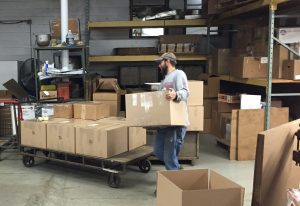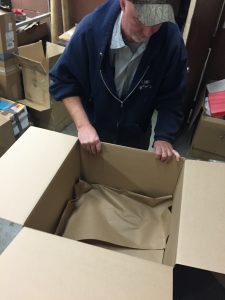
01 Dec What’s in the Package?
There are times in the year when it seems we cannot keep shipping boxes in the shop, when we’re receiving deliveries from our box maker every few weeks. This is partly because we still have not mastered anticipation of demand, but also because in a shop where open flame forges and molten metal need lots of space, there’s only so much of it we can spot to paper products. If we had, say, a separate warehouse just for packaging, would we buy, store and use more of it? Probably not.
It comes up now and again that BCC does not have much of an “out of box experience”, that there’s not much of a “reveal” when we arrive at the door. How we get BCC to you is of critical importance to us; given how much energy and time it takes to hand-make each piece, to have anything go wrong in the last few days from our loading dock to your front door would be tragic in many senses of that word.  The cookware industry promulgates all sorts of guidelines for cookware shipping, starting with die-cut presentation boxes and ending with shipping label placement, covering every conceivable concern in between from dead-weight acceleration factors to paper board burst strength to styrofoam compression rates. Anybody who moves large chunks of expensive metal around the globe would take an interest.
The cookware industry promulgates all sorts of guidelines for cookware shipping, starting with die-cut presentation boxes and ending with shipping label placement, covering every conceivable concern in between from dead-weight acceleration factors to paper board burst strength to styrofoam compression rates. Anybody who moves large chunks of expensive metal around the globe would take an interest.
We’ve known since the beginning that you buy BCC at least in part because it’s sustainably made. Every bit of every pan we make would be recyclable, were it to come to that, but all of the “drips, drops and dross” that we produce in casting, shaping, lining and finishing your pan get bundled and sent back to our metal suppliers for melting down and circulating back to us as usable raw materials. There’s practically no waste entailed in working with pure metals, and that was just as appealing to us when we started the company as we understand it is to you. We extend that thinking to as much and in as many directions as we can in our small operation, including to how we send BCC on its way out the door.
Presentation packaging is a subspecies of marketing, its function being to shift a casual encounter (for example, on display in a retail store) into a buying decision. The wine industry is famous for packaging the same bulked varietal blends behind cleverly diverse labels (“Warted Frog”, “Criminal Intent”, “Cardinal Zin”, etc.) to appeal to different demographics and motivations. On a shop shelf you may come across two adjacent bottles of “Northern California” pinot noir with widely different labeling and “tasting notes” containing exactly the same fermented grape juice within. I don’t think there’s anything wrong with that so long as what comes out of the bottle is what the bottle tells you it is – in this case California pinot noir. Everything else is subjective, and, frankly, part of the fun of navigating wine.
Since BCC doesn’t appear on retail shelves and is (almost) never an impulse purchase, I consider come-hither packaging almost in insult to you, the person who has already made a firm, informed decision for BCC. The pretense of affirming your decision with an impression of anything other than a quality piece of cookware, much less in the form of a stylish veneer that’s fated to be discarded, would be an expensively wasteful conceit on our part, an added cost to you, and a cumbersome material handling issue everywhere along the line. Having talked with so many of you over the years about acquiring BCC, having your existing wares restored, cooking in general, and lots else to do with using pure metal in the kitchen, my belief is that BCC has a relationship with you well before we get down to doing business, which I would rather honor than signal to you that I believe otherwise.
This is why BCC arrives to you in the proverbial “plain, brown wrapper”. We want to spend your money only on what you can use, and we’ll take every step we can to minimize its impact. In the case of BCC itself, that means 100% renewability, extremely low production waste (not quite zero, but very close) and extraordinary energy efficiency. In the case of what else we send you, the packaging, it means post-consumer recycled paper cartons, no ink (the BCC logo is literally branded into each box), 100% recyclable kraft paper dunnage, and emailed usage guides.  We reckon robust shipping materials are things you can use, in as much as you want your wares to arrive safely to their new home as much as we do. Expensively printed, die-cut custom “cradle” packages in various configurations taking up 250% more storage space while waiting for your order, not so much.
We reckon robust shipping materials are things you can use, in as much as you want your wares to arrive safely to their new home as much as we do. Expensively printed, die-cut custom “cradle” packages in various configurations taking up 250% more storage space while waiting for your order, not so much.
While the goal for everything that leaves the BCC shop is recyclability or biodegradability, it’s still a goal. One thing we have yet to nail down to our liking is the bag we wrap around each piece of BCC, which in order to prevent oxidation of the copper while it’s traveling to you, is currently an impermeable poly-bag. More lamentably, we’ve only been able to find bags thick enough to protect heavy pans at most 5 – 15% recycled content, but most of the time it’s 0%. We’re constantly looking out for biodegradable films and O2 barriers that would work as well, but for now it’s a poly bag or a soluble polymer lacquer such as is used on most imported copper cookware (the latter, in our opinion, causes more trouble than it’s worth and ends up in the water supply rather than a landfill). The leading edge of biodegradable air-tight packaging today are vaporized aluminum films that can be bonded to plant-based polymers, but in our application the aluminum layer would electrolytically react with more conductive copper, which makes off with the aluminum’s electrons, causing film degradation at the atomic level and quickly admitting O2.

We also tried paper tape for our cartons early on, and had more than a few instances of adhesives and seams letting go in transit owing to copper cookware’s large “acceleration force” in logistics handling. For now we’re using polymer film packing tape – not ideal, but has the little bit of stretch needed to absorb movements of inert masses its containing without letting loose. Not optimal, but probably beats unboxed copper cookware clanking around inside a UPS truck.
We’ll keep exploring and chasing down leads as they show up (which they do with increasing frequency since companies big and small are thoughtful about all this lately). In the meantime we’re staying focussed first on the vessel most important to both of us, the one that will be with you for the rest of your life and many lives to follow. The outer vessel in which the first vessel arrives has serious work to do getting your BCC safely to you, so we specify a pretty burly box and lots of clingy dunnage to keep everything stable underway, then we take care to pack it carefully. Once it’s delivered its charges to you we intend for it to simply leave your life and household with minimal fuss, en route to resurrection in some new, low-impact form.
That, to us, means keeping it simple.

